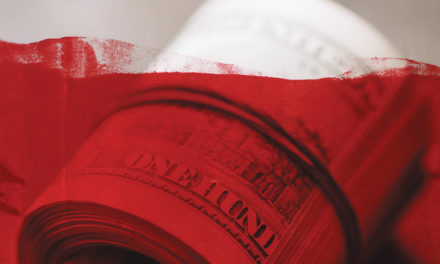Almost 100 years ago, eight Chicago White Sox players were given lifetime bans from Major League Baseball for consorting with gamblers to throw the 1919 World Series. Seventy years later, baseball’s all-time hits leader, Pete Rose, was similarly banned for purportedly betting on his own team—to win, no less.
Today, something far more sinister than either of those scandals is taking place, yet the elected officials responsible for protecting the public welfare blindly whistle past the graveyard, focused more on how they can profit off their constituents. Just as they previously did with Power Ball jackpots and similar lottery schemes, today’s politicians are primed to once again use the lure of easy money through gambling to pad their political coffers, regardless of the clear and present dangers that await their reckless rush to legalize sports betting.
In order to properly grasp this dereliction of duty, it’s important to understand the background of what’s taking place.
There’s a quickly growing trend in which major league sports teams focus on “rebuilding” when they feel they aren’t able to compete for the championship. This “rebuilding” comes in the form of subtly angling for top draft picks, which are inanely awarded to the teams with the worst records. In other words, teams that are not among the best in the league increasingly find it more beneficial to losegames than to win.
But the players on the field aren’t the ones making a mockery of the competition. That’s happening at the ownership/executive level, where coaches are being directed to essentially throw games by subtle decisions like keeping stars and otherwise useful players on the bench with minor “injuries” or even for arbitrary “rest.” They also make a point of regularly fielding sub-optimal lineups under the guise of “getting a look” at more marginal players.
With arguably a third of the teams at any one time more interested in “rebuilding” than competing, that means over half the regular-season games being played involve at least one team organizationally taking a dive, as a tsunami of “tanking” washes over our major sports leagues (Major League Baseball, National Football League, National Basketball Association, National Hockey League). The maneuvers related to this tanking are often accompanied by comments along the lines of “because there is nothing to play for.” Of course, this really means because there is nothing to win for, yet plenty to lose for.
When the U.S. Supreme Court struck down a federal law prohibiting sports gambling in May, it opened the door for wagering on sports to be legalized on a state-by-state basis. With many state and local governments strapped for the cash needed to fund their ever- increasing array of spending projects, it’s not surprising that the knee-jerk inclination is to “get a piece of the action.” We see the same thing occurring as states increasingly move to legalize—and tax—the dubious practice of growing and selling marijuana.
Against this absurd backdrop, state legislators around the country are suddenly racing to legalize wagering on games that lack competitive integrity for the unwitting public whose interests they’ve been trusted to protect. Would legislators in retrospect excitedly encourage fans to bet on the 1919 World Series? Of course not. Why? Because the purity of the competition was severely compromised. So why would they be so enthusiastically supporting increased access to gambling now?
It’s all about money, of course—and we’re not talking about the money a very small percentage of gamblers might win. We are talking about the money states will rake in, just as they do with lotteries, where the vast majority who play are losers. The increasing scientific evidence, along with the long-held anecdotal evidence of how gambling is a bad bet for individuals and communities is secondary to the money that can be gained by those involved in its operation. This explains why even the sports leagues themselves are suddenly behind the movement to not only allow, but to promote gambling on their games from coast to coast.
You’ve Got to Know When to Hold ’Em
Before we consider more deeply the merits of state legislators rushing to increase the ease of their constituents risking hard-earned money on integrity-lacking athletic events, we should consider an even more fundamental question: Why would the sports leagues themselves ever create such a misguided format that rewards teams for losing games?
Sadly, it’s all the byproduct of a misunderstood decision dating back to the formative days of the NFL. Founded in 1920, the fledgling teams of the nascent league struggled with financial losses amid lukewarm fan interest as the college game was widely considered to be a superior product. Most college stars of the day wisely parlayed their gridiron success into “real” jobs that would enable them to support a family for their subsequent adult life.
Early NFL teams soon realized that in order to gain local football fans’ interest, they would do well to entice players with star power from local schools to turn pro once their collegiate careers concluded. This forced teams to begin paying star college players more money in hopes of convincing them to forego a more traditional career.
As the NFL began to gain its footing moving into the 1930s, teams began to more actively recruit star players off college campuses, regardless of proximity, in an effort to improve the team’s talent level.
As this recruiting increased, players began to recognize that not only could they leverage a potential non-football employer against NFL teams in hopes of a bigger contract, but they could also increasingly pit multiple teams against each other. NFL owners quickly realized that engaging in bidding wars among themselves was destined to quickly undermine the financial stability of the league. This drove several owners to consider what methods might be used to effectively strip unproven players of what was essentially unrestricted free agency.
The solution was to undercut the players’ negotiating leverage by arbitrarily assigning their contract “rights.” The owners decided they needed a system by which each team would be assigned exclusive negotiating rights to specific players. The mechanism they created eventually came to be known as a “draft.” The fact that this new rule, proposed by the owner of the last-place team, specified these selections take place in reverse order of the prior season’s standings was, of course, secondary to the fact that it put an end to bidding wars among the league’s owners.
With present-day signing bonuses reaching what most consider to be exorbitant levels even without the teams bidding against each other, the origins of the draft’s inception have been long forgotten. Most fans and even insiders today erroneously believe the draft’s primary purpose is to arbitrarily direct the best incoming talent to the worst teams. Because even the powers that be in the leagues themselves share this misconception, they steadfastly cling to the flawed structure of the draft as an inalienable part of the league’s foundation, even as teams increasingly pervert its purported intent.
Know When to Fold ‘Em
One other important aspect of pro sports that has changed over the years is the importance of fielding a reasonably competitive team. Back in the mid-’30s when the draft was first implemented, teams couldn’t afford to go into “rebuilding” mode with no thought as to whether they were competitive in the current season. There were no such things as guaranteed television contracts or seat licenses or any similar avenues that would keep the cash flowing when fans thought teams weren’t putting their best foot forward to win every time they took the field.
This brings us back to the current day and why not only teams, but the leaders of the leagues, would continue to support a system that so clearly lacks integrity of competition. For poorly run teams, the structure provides cover, as they can repeatedly sell inept decision-making as a “focus on the future.” The worst-run teams are continually bailed out by a backward system that rewards ineptitude with top draft picks which might well make them competitive for a stretch in spite of their incompetence.
The league commissioners, who are hired and fired at the whims of the collective group of owners, likewise have little incentive to change the system. The winning teams are not anxious to encourage increased competence among the league’s bottom-feeders, who in turn use the broken welfare system as the aforementioned crutch.
But why are the leagues suddenly in favor of legalizing gambling after fighting to prevent its association for more than a century? Again, it relates directly to the tanking. Who cares about watching a game between one team that has incentive to win and an opponent who has incentive to lose? Someone who bet money on the result, of course. Even a game that is predicted to be a lopsided blowout can be “exciting” to the gambler, as the bet normally encompasses a point spread that supposedly makes it even.
Know When to Walk Away
The problem, however, when one team is “taking a dive,” is that predicting the effort level of that team, from the coaching staff all the way up through the front office to the owner, is fraught with often unforeseen developments, as teams are prone to make curious lineup and strategy decisions seemingly without warning. In fact, it could be argued that only those continuously monitoring the machinations of a tanking team closely are able to discern the probability of a particular outcome with any reasonable degree of success.
Of course, very few recreational gamblers—the very ones who will be targeted with ads and other lures that will naturally follow widespread legalization of gambling—fit that description. These recreational gamblers are the ones who are most prone to bet on the game “for the thrill” of the action. Professional sports books’ business is to monitor even the most miniscule maneuvers that might impact every aspect of the game’s outcome. This is reflected in the bottom line of commercial wagering. In June 2018, Nevada sports books won $20.1 million, marking the 59th consecutive month—since July 2013—that the books have come out ahead of the poor saps placing bets on sporting events.
So, why do ordinary citizens continue to place wagers even when they know they are at a significant disadvantage going up against pros? Advances in neuroscience have revealed that gambling alters brain function in much the same way as drug use. While addiction was once considered to be dependence on a chemical (like drugs), advances in neuroscience have led experts to define addiction as repeatedly pursuing a rewarding experience despite serious repercussions. This “experience” could range from the high gained from using cocaine or heroin to the thrill of winning a big bet. The obvious risk accompanying both types of addictions is ignored by addicts in their continual quest for an increasingly higher high.
And Know When to Run
As if this insight regarding how gambling can easily lead to addiction is not sobering enough, consider that more than 80 percent of gambling addicts never seek treatment for their addiction. Furthermore, of the few who do seek treatment, approximately three quarters return to the source of their gambling addiction. That means approximately 95 percent of people who become addicted to gambling never break that addiction.
It is quickly becoming crystal clear that exponentially increasing the ease of access to gambling while at the same time removing its stigma is a recipe for disaster. Throw in the prospect of approximately one-third of the teams having incentive to throw games, and the foreboding peril to unwary American sports fans is quite ominous.
With the knowledge of how vulnerable gamblers are to succumbing to addiction if left unchecked, how can anyone responsible for protecting the public’s welfare reasonably argue that legalizing gambling is wise policy? Even if one were to obtusely argue that gambling’s risk-addiction dangers are exaggerated, the ignorance of legalizing gambling at the height of the tanking era is a failure to exercise due diligence and an absolute dereliction of duty.
Any public official who promotes or supports such legislation is blinded either by greed or ignorance, and most likely a combination of both. We must implore our representatives in office to become educated about not only the very real risks that accompany what they are legalizing, but the environment into which they are leading their unwitting constituents.
Our legislators are about to make a big bet—one in which there will most certainly be winners and losers. Sadly, the side on which most voters will fall is plain to see. For many, these losses will come in the form of somewhat disposable income. For others, they will be far worse.
The only way to win is to not start gambling, and the best way to accomplish that is to get our legislators to open their eyes to see beyond their delusions of “easy” money.
Originally published in the October 2018 issue of Citizen magazine.
Brad Kullman is a human performance specialist who worked as a professional scout and high-ranking executive in Major League Baseball. He has been studying the impact of the brain on performance in athletes and the general population for almost 20 years. Kullman is the author of Losing (To Win): How Incentivized Losing Undermines the Integrity of Our Major Professional Sports Leages (Discernment Press, 2017) and Hardwired for Life: Human Understanding Beyond Surface Personality (Discernment Press, 2017). He is also the founder of MaxQPerformance.com, which specializes in helping people realize their innate giftedness to achieve next-level success.






